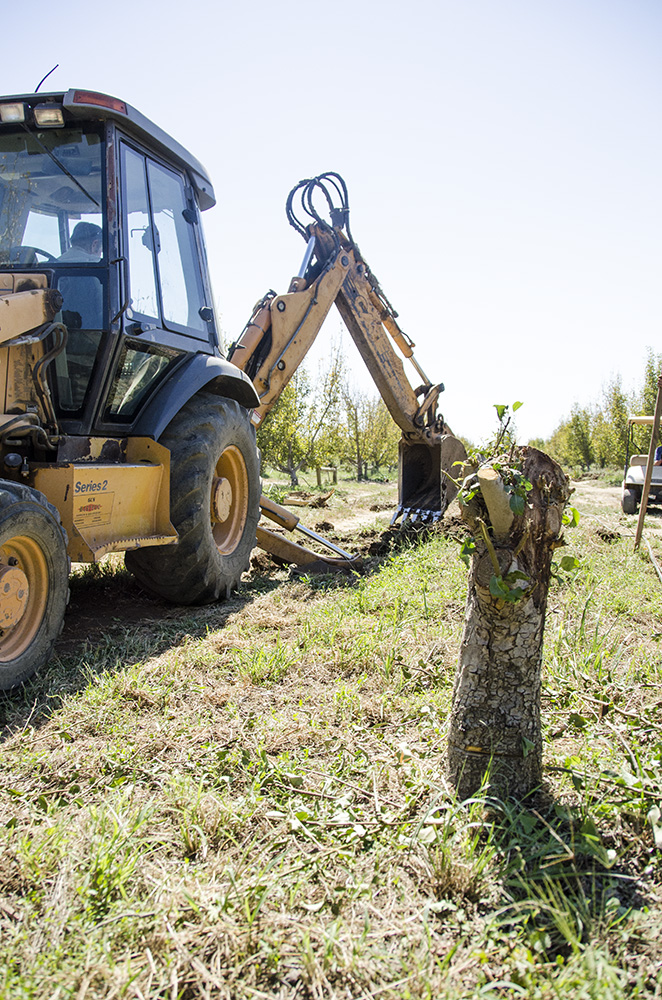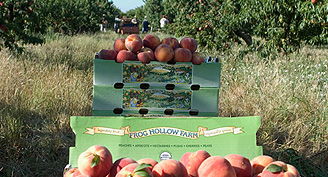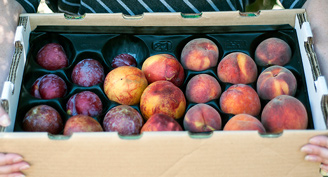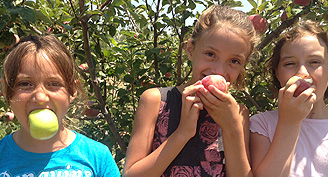THIS WEEKS FRUIT
Emerald Beaut Plums
A freestone plum, the Emerald Beaut is a delicate green that turns golden with a hint of a blush. It has a firmer texture than the Santa Rosa with a crisp almost crunchy mouthfeel. One of our most hardy fruit, the Emerald Beaut just gets sweeter and sweeter without losing texture as it ages.
The Flavor Heart Pluots
The Flavor Heart gets its name from its distinctively tapered shape. Its meaty, pale yellow flesh is very low in acid and the sweetness and color contrasts strikingly with its dark purple almost black skin.
Hosui Pears
Hosui have flesh, that while still crunchy has a more melting mouthful, making the texture combination when eaten out of hand spectacular. Very juicy and sweet with a milder pear taste, their round shape and beautiful golden hue make them ideal for presentation with a distinctively Autumnal feel.
Warren Pears
The Warren is to our pears as the Cal Red is to our peaches. This is Frog Hollow Farm’s signature pear and for good reason. Too difficult to grow for most farmers to consider it’s never caught on commercially but Farmer Al has never shied away from putting the time and effort into a fruit that tastes so good. It has a classic European texture, very soft and juicy with a silky sweetness that avoids the typical grittiness found in most pears.
Heirloom Apples
We grow a few varieties of heirloom apples, but not enough of each variety to pack everyone the same ones. You will receive some configuration of these varieties – Cox’s Orange Pippin, Ashmead’s Kernel, Belle de Boskoop, and Jonathan.
Lamb Hass Avocado
Abounding Harvest Mountain Farm, Los Gatos CA
Lamb-Hass is a cross between the traditional Hass and a Gwen (Dwarf ) Avocado. A late season avocado with a rich and nutty flavor.
**Varieties subject to change**
A NOTE FROM FARMER AL

Dear CSA Members,
By all accounts, 2014 has been the most devastating year for fire blight disease in recent memory. Fire blight is a bacterial disease, which can kill branches and entire trees within weeks from the time of original infection. The leaves turn black, giving the trees a “scorched” look, thus the term “fire blight.” The infections occur when rain and warm 50F-60F temperatures coincide with soft tissue and rapid growth such as blossoms and early spring shoot growth.
So we lose all of the current season’s crop and the entire tree, meaning no crop for years to come. We tried to stop the disease in a tree once the infection was identified but to no avail. It looks like we lost over 300 Bosc trees out of the original 500. In the Taylors Gold variety the losses are similar.
It has been discouraging to walk through the pears throughout the summer to see nothing but stumps where once towered the tall graceful branches of these elegant cultivars. So last week I called Ron, our backhoe guy, to come and begin the sad process of stump and root removal. After working three full days last week, he’s still not done. But the orchard looks so much better now with the unsightly stumps gone and only fresh day soil instead, even though these long oval mounds of earth resemble grave sites, which in a sense they are!
So we’ll replant with renewed hope, and we’ll bank on our compost and compost tea program to change the microbial ecology of the orchard from the soil on up to the tips of each branch and each leaf. Come to think of it, since this approach has never before been tried, we should invite the UC Scientific teams to come and monitor it. Do a Study!
We’ll keep you posted.









